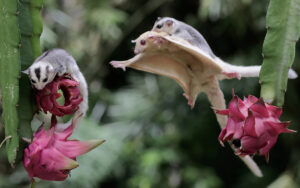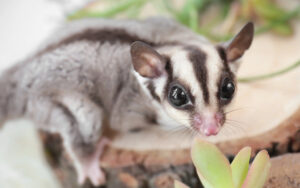Thinking about adding a sugar glider to your family? These wide-eyed, gliding marsupials are undeniably adorable and fascinating to watch. But before you go falling head over tail, it’s important to understand what life with a sugar glider really looks like. Spoiler: they’re not your average small pet.
This guide will walk you through everything you need to know about pet sugar gliders—from what they eat and how much they sleep (a lot), to why they might bark in the middle of the night and whether they’re the right fit for your lifestyle.

What Is A Sugar Glider, Anyway?
Sugar gliders (Petaurus breviceps) are small, nocturnal marsupials native to Australia, New Guinea, and Indonesia. They get their name from their love of sweet foods and their ability to glide through the air using a membrane that stretches from their wrists to their ankles.
- Size: Around 5-7 inches long, plus a bushy tail almost the same length
- Weight: 3-6 ounces (about the weight of an apple)
- Lifespan of a sugar glider in captivity: 10–15 years with proper care
- Social needs: Extremely social—ideally kept in pairs or small groups
- Activity level: Nocturnal and very active at night
Sugar Gliders as Pets Pros and Cons
Let’s start with some real talk. Sugar gliders can be wonderful companions—but they’re not ideal for every household.
✅ What We Love:
- Unique and interactive: They can bond closely with their humans and even ride around in your pocket or hoodie.
- Long lifespan: Compared to many other small animals, their longevity allows for a lasting bond.
- Quirky behavior: They “bark” like tiny puppies, glide through the air, and cuddle in pouches. What’s not to love?
⚠️ What to Consider:
- They’re nocturnal: Ready for playtime at 2 a.m.? Because they are.
- They’re not solitary pets: Keeping a single glider is strongly discouraged. They can get lonely, depressed, and even self-mutilate.
- Special dietary needs: A sugar glider’s diet isn’t as simple as pellets and water. It requires planning and variety.
- They can be loud and messy: They scent-mark, fling food, and may scream (yes, scream) when they’re upset or excited.
- Expensive to care for properly: Between vet visits, proper diet, and a large enclosure, costs can add up fast.

Habitat: Creating the Perfect Home
Sugar Glider Cages—Size and Setup
Sugar gliders need a lot of vertical space. A tall, multi-level cage with plenty of branches and gliding room is a must.
- Minimum size for a pair: 24”W x 24”D x 36”H—but bigger is always better
- Bar spacing: No more than ½ inch
- Must-haves:
- Nesting pouch or fleece sleeping cube
- Climbing ropes and branches
- Exercise wheel (solid surface, no mesh!)
- Toys for mental stimulation
- Food and water dishes or glider-safe bottles
Cleanliness and Scent
Sugar gliders mark their territory with scent glands, so be prepared for a bit of funk. Frequent spot-cleaning and weekly deep cleans will help manage the smell.
Tip: Avoid using strong-smelling cleaners or air fresheners near their cage. These guys are sensitive.
Diet: What Do Sugar Gliders Eat?
This is one of the trickiest parts of sugar glider care—and one of the most critical.
🍽️ Diets For Sugar Gliders—What to Feed:
Sugar gliders are omnivores and need a balanced mix of protein, fruits, veggies, and calcium. Their diet should consist of:
- Fresh fruits and vegetables (papaya, berries, leafy greens, carrots, sweet potatoes)
- Protein sources like cooked chicken, eggs, or insects (mealworms, crickets)
- Specialized glider food or homemade staple diets like BML (Bourbon’s Modified Leadbeater’s), TPG (The Pet Glider diet), or HPW (High Protein Wombaroo)
- Calcium supplements to prevent nutritional deficiencies
❌ Foods to Avoid:
- Chocolate
- Caffeine
- Garlic and onion
- Artificial sweeteners
- Raw lima beans
- High-fat or salty snacks
Pro tip: Always research any new food before offering it, and when in doubt, stick to glider-safe staples.

Behavior and Bonding
Sugar gliders are intelligent, affectionate, and curious—but they take time to warm up to you. Earning their trust is a process.
How to Bond with Your Glider
- Spend time with them every day, ideally during their waking hours (evenings and early mornings)
- Use a bonding pouch worn around your neck during the day
- Offer treats from your hand (yogurt drops, small fruit pieces)
- Talk to them softly so they learn your voice
Patience is key. It can take weeks or even months for a sugar glider to fully trust you.
Common Behaviors:
- Crabbing: A loud, angry-sounding noise—usually made when they’re scared or annoyed.
- Barking: A sign of communication or boredom.
- Gliding: Not all pet gliders will glide frequently, but it’s a natural behavior they’ll use if they have room.
- Grooming: Includes self-grooming and social grooming (especially if housed with a buddy).

Veterinary Care and Health
Sugar glider care includes visits with exotic pet vets familiar with marsupials. Routine care is essential to keep them thriving.
Find a Vet Before You Need One
Not all vets treat sugar gliders, so do your homework before an emergency arises. Yearly checkups are recommended.
⚠️ Common Health Issues:
- Nutritional deficiencies: Can lead to hind-leg paralysis and other serious problems.
- Obesity: Often due to too many treats and not enough exercise.
- Parasites or infections: Especially if hygiene isn’t maintained.
- Injuries from poor cage setups or rough handling
Legal Considerations: Are They Legal Where You Live?
Before you fall in love and bring one home, check your local laws. Sugar gliders are not legal everywhere in the U.S.
❌ Banned or restricted in:
- California
- Alaska
- Hawaii
- Some cities/counties in Pennsylvania and Massachusetts
Some places also require special permits. Don’t skip this step—it’s heartbreaking to have to rehome a beloved pet because of legal issues.

Are Sugar Gliders Right for You?
Let’s break it down:
| Question | If you answer | Sugar gliders may be… |
|---|---|---|
| Do you stay up late or have time in the evening? | Yes | A good match |
| Are you okay with exotic pet costs and care? | Yes | A good match |
| Do you want a quiet, low-maintenance pet? | No | Not a good match |
| Can you commit to 10–15 years? | Yes | A good match |
| Will you adopt at least two gliders? | Yes | A good match |
Final Thoughts: Tiny Marsupials, Big Responsibilities
Sugar gliders as pets aren’t for everyone, but if you’re ready to meet their needs, they can be deeply rewarding companions. Just don’t mistake them for low-maintenance “starter pets.” These little guys are as complex as they are charming.
If you’re still interested, take the next step by researching reputable breeders or checking with exotic pet rescues. And don’t forget to prep your home—and your heart—for a long-term commitment.
